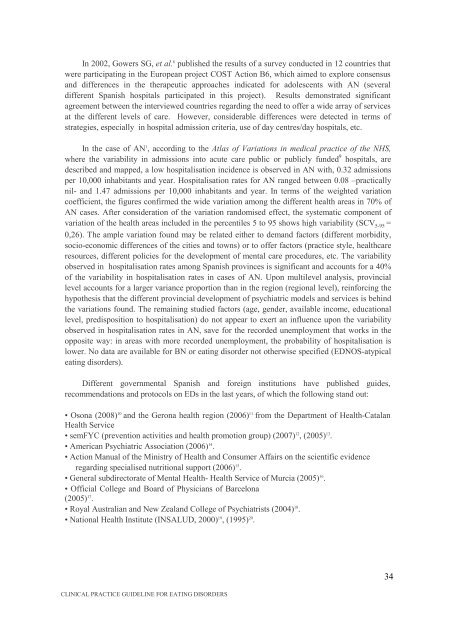CPG for Eating Disorders
CPG for Eating Disorders
CPG for Eating Disorders
Create successful ePaper yourself
Turn your PDF publications into a flip-book with our unique Google optimized e-Paper software.
In 2002, Gowers SG, et al. 8 published the results of a survey conducted in 12 countries thatwere participating in the European project COST Action B6, which aimed to explore consensusand differences in the therapeutic approaches indicated <strong>for</strong> adolescents with AN (severaldifferent Spanish hospitals participated in this project). Results demonstrated significantagreement between the interviewed countries regarding the need to offer a wide array of servicesat the different levels of care. However, considerable differences were detected in terms ofstrategies, especially in hospital admission criteria, use of day centres/day hospitals, etc.In the case of AN 1 , according to the Atlas of Variations in medical practice of the NHS,where the variability in admissions into acute care public or publicly funded 9 hospitals, aredescribed and mapped, a low hospitalisation incidence is observed in AN with, 0.32 admissionsper 10,000 inhabitants and year. Hospitalisation rates <strong>for</strong> AN ranged between 0.08 –practicallynil- and 1.47 admissions per 10,000 inhabitants and year. In terms of the weighted variationcoefficient, the figures confirmed the wide variation among the different health areas in 70% ofAN cases. After consideration of the variation randomised effect, the systematic component ofvariation of the health areas included in the percentiles 5 to 95 shows high variability (SCV 5-95 =0,26). The ample variation found may be related either to demand factors (different morbidity,socio-economic differences of the cities and towns) or to offer factors (practice style, healthcareresources, different policies <strong>for</strong> the development of mental care procedures, etc. The variabilityobserved in hospitalisation rates among Spanish provinces is significant and accounts <strong>for</strong> a 40%of the variability in hospitalisation rates in cases of AN. Upon multilevel analysis, provinciallevel accounts <strong>for</strong> a larger variance proportion than in the region (regional level), rein<strong>for</strong>cing thehypothesis that the different provincial development of psychiatric models and services is behindthe variations found. The remaining studied factors (age, gender, available income, educationallevel, predisposition to hospitalisation) do not appear to exert an influence upon the variabilityobserved in hospitalisation rates in AN, save <strong>for</strong> the recorded unemployment that works in theopposite way: in areas with more recorded unemployment, the probability of hospitalisation islower. No data are available <strong>for</strong> BN or eating disorder not otherwise specified (EDNOS-atypicaleating disorders).Different governmental Spanish and <strong>for</strong>eign institutions have published guides,recommendations and protocols on EDs in the last years, of which the following stand out:• Osona (2008) 10 and the Gerona health region (2006) 11 from the Department of Health-CatalanHealth Service• semFYC (prevention activities and health promotion group) (2007) 12 , (2005) 13 .• American Psychiatric Association (2006) 14 .• Action Manual of the Ministry of Health and Consumer Affairs on the scientific evidenceregarding specialised nutritional support (2006) 15 .• General subdirectorate of Mental Health- Health Service of Murcia (2005) 16 .• Official College and Board of Physicians of Barcelona(2005) 17 .• Royal Australian and New Zealand College of Psychiatrists (2004) 18 .• National Health Institute (INSALUD, 2000) 19 , (1995) 20 .CLINICAL PRACTICE GUIDELINE FOR EATING DISORDERS34

















